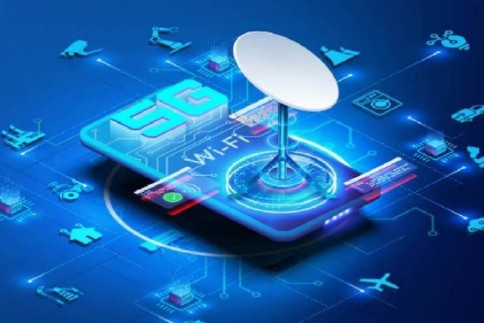
The technical view of 5G, the fifth generation of mobile networks, encompasses a wide range of advanced technologies and architectural innovations designed
to enhance connectivity, speed, and efficiency. Here’s an overview of the key technical aspects of 5G:








1. Radio Access Network (RAN)
Millimeter-Wave (mmWave): 5G utilizes high-frequency bands, specifically mmWave spectrum (above 24 GHz), to achieve ultra-high-speed data rates. This spectrum allows for massive bandwidth, but has limited range and penetration.
Sub-6 GHz Bands: These include frequencies below 6 GHz, offering a balance between coverage and speed. They provide broader coverage compared to mmWave but with lower data rates.
Massive MIMO (Multiple Input Multiple Output): 5G networks employ large numbers of antennas at the base stations, enabling simultaneous transmission and reception of multiple data signals. This significantly increases capacity and spectrum efficiency.
Beamforming: This technology directs signals to specific users rather than broadcasting in all directions. It enhances signal strength, reduces interference, and improves coverage, especially in dense urban environments.
2. Core Network Architecture
Network Slicing: 5G allows for the creation of multiple virtual networks (slices) on a single physical infrastructure. Each slice can be tailored to specific applications or industries, with customized latency, bandwidth, and reliability.
Edge Computing: 5G networks integrate edge computing, bringing computation and data storage closer to the location where it is needed. This reduces latency and enables real-time processing for applications like autonomous vehicles and IoT.
Service-Based Architecture (SBA): 5G core networks adopt a service-based architecture, which is more flexible and modular compared to the previous generation. Network functions are delivered as services, making the network more agile and scalable.
3. Performance Enhancements
Ultra-Reliable Low-Latency Communication (URLLC): 5G is designed to support mission-critical applications with stringent requirements for low latency (as low as 1 ms) and high reliability. This is essential for applications like remote surgery and autonomous driving.
Enhanced Mobile Broadband (eMBB): 5G significantly improves peak data rates (up to 10 Gbps) and user experiences for data-intensive applications such as 4K/8K video streaming and virtual reality.
Massive Machine-Type Communications (mMTC): 5G supports a massive number of connected devices (up to 1 million devices per square kilometer), crucial for the Internet of Things (IoT) ecosystems.
4. Security Enhancements
Enhanced Authentication and Encryption: 5G introduces stronger security protocols, including enhanced encryption and mutual authentication between devices and the network, to protect against cyber threats.
Network Function Virtualization (NFV) and Software-Defined Networking (SDN): These technologies enable more dynamic and flexible security measures, allowing for rapid deployment of security services and isolation of potential threats.
5. Spectrum Efficiency
Dynamic Spectrum Sharing (DSS): This technology allows 5G and 4G LTE to coexist on the same spectrum band, enabling a smooth transition and better utilization of available spectrum.
Carrier Aggregation: 5G can combine multiple spectrum bands to increase data rates and network capacity, making more efficient use of available resources.
6. Energy Efficiency
Power Savings Modes: 5G networks implement advanced sleep modes and energy-saving technologies to reduce power consumption, especially in scenarios with low traffic.
Optimized Resource Allocation: 5G networks dynamically allocate resources based on demand, optimizing power usage and reducing overall energy consumption.
7. Deployment Models
Non-Standalone (NSA) Mode: In the initial phase, 5G networks were deployed alongside existing 4G infrastructure, using 4G LTE for control signaling while delivering data over 5G.
Standalone (SA) Mode: Eventually, 5G networks will operate independently of 4G, with a fully virtualized and cloud-native core network, enabling all 5G capabilities.
8. Backhaul and Transport Networks
High-Capacity Backhaul: To support the massive data rates and low latency of 5G, high-capacity backhaul solutions, such as fiber optics, microwave links, and satellite backhaul, are crucial.
Fronthaul Networks: The interface between the centralized unit and the distributed unit in the RAN is critical for enabling the low latency and high data rates of 5G.
9. Ecosystem and Interoperability
IoT Integration: 5G is designed to integrate seamlessly with IoT devices, supporting diverse use cases across various industries, from smart cities to industrial automation.
Interoperability with Previous Generations: 5G networks are designed to coexist with 4G and even 3G networks, ensuring a smooth user experience and broad device compatibility during the transition period.
10. Challenges and Considerations
Infrastructure Costs: Deploying 5G infrastructure, especially in mmWave frequencies, is capital-intensive due to the need for dense small cell deployments.
Regulatory and Spectrum Management: Effective management of spectrum allocation and adherence to regulatory requirements are critical for the global rollout of 5G.
5G is poised to revolutionize communication, enabling new applications and business models across industries. However, its implementation involves complex technological advancements and requires significant investment and collaboration across the telecom ecosystem.

Leave a Reply